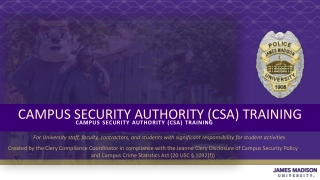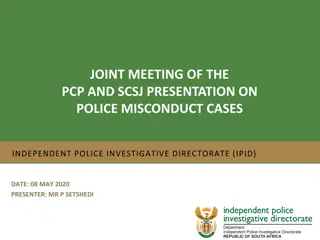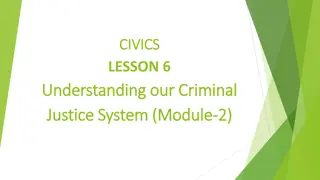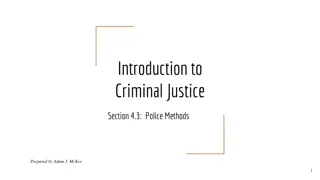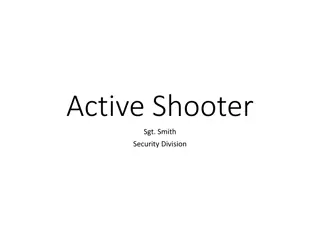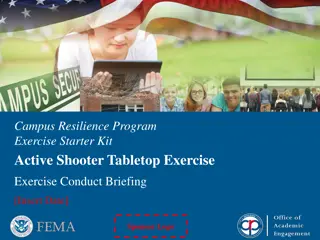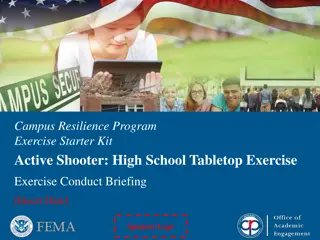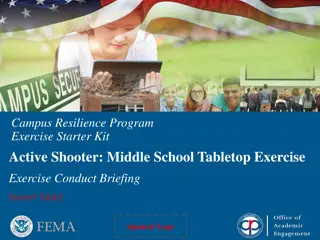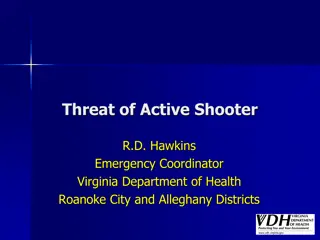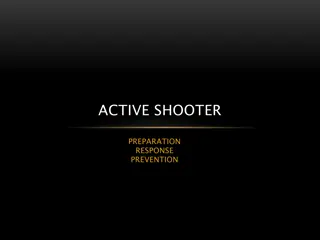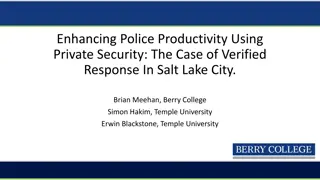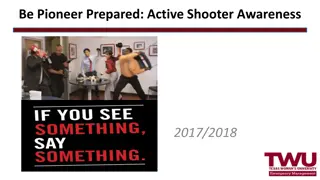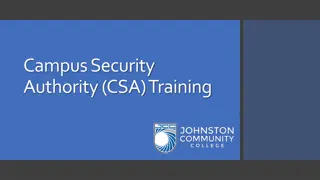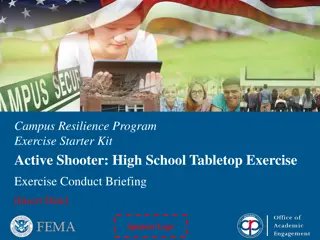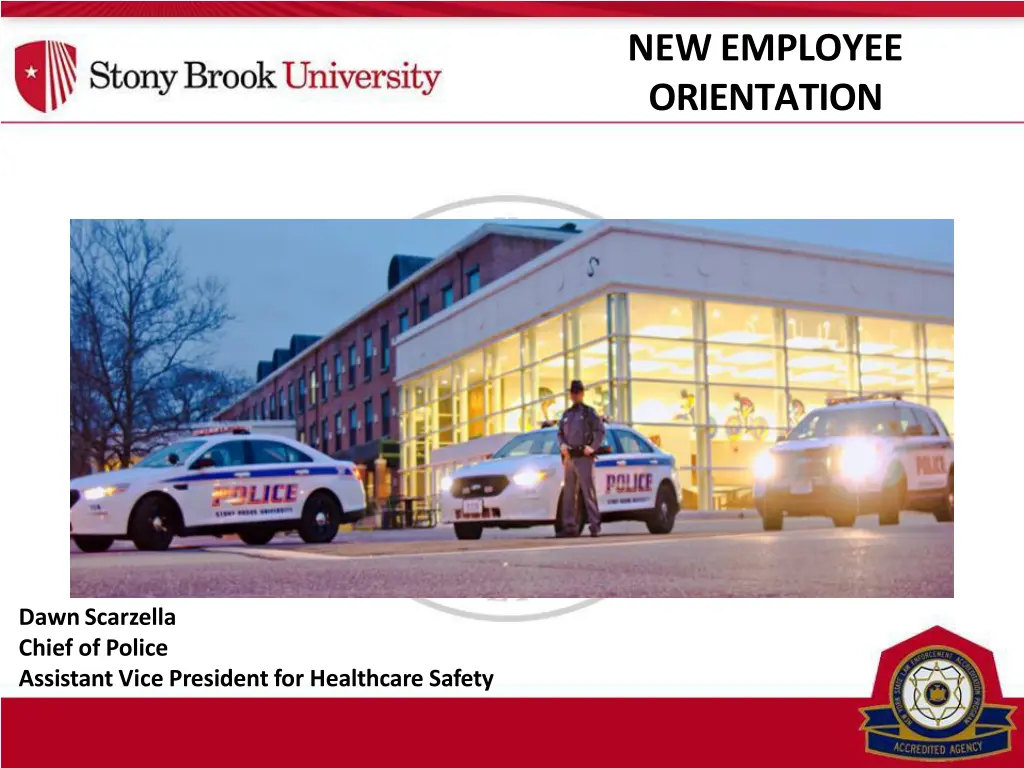
University Police Department Overview and Campus Safety Measures
Discover an in-depth overview of the University Police Department, including key information on patrol operations, emergency management, public safety initiatives, and campus emergency communications. Learn about the SB Guardian Personal Safety System and the importance of compliance with the Jeanne Clery Campus Security Policy and Crime Statistics Disclosure Act.
Uploaded on | 1 Views
Download Presentation

Please find below an Image/Link to download the presentation.
The content on the website is provided AS IS for your information and personal use only. It may not be sold, licensed, or shared on other websites without obtaining consent from the author. If you encounter any issues during the download, it is possible that the publisher has removed the file from their server.
You are allowed to download the files provided on this website for personal or commercial use, subject to the condition that they are used lawfully. All files are the property of their respective owners.
The content on the website is provided AS IS for your information and personal use only. It may not be sold, licensed, or shared on other websites without obtaining consent from the author.
E N D
Presentation Transcript
NEW EMPLOYEE ORIENTATION DawnScarzella Chief of Police Assistant Vice President for Healthcare Safety
University Police at a Glance Sworn law enforcement agency Consisting of uniformed members (42 police officers, 9 supervisors, 5 detectives, and 9 command staff, 65 totaluniformed members) Graduates of the Suffolk or Nassau County PoliceAcademy Achieved New York State DCJS Reaccreditation in December of 2020 110 required standards
University Police at a Glance Patrol Operations Community Relations Special Events Specialized Programs Office of Emergency Management Access Control Investigations Division
University Police Public Safety of East Campus Director of Public Safety for East Campus Operations University Police are assigned to East Campus Associate Director of Pubic Safety Security Services Assistants(SSA s) 24 hour coverage throughout the University Hospital Main Entrance Emergency Department Comprehensive Psychiatric Emergency Program (CPEP)
Campus Emergency Communications Provides text, voice, and e-mail to the campus community Emergency Management Website (SB Advisory & SB Alert) Campus wide LCD panels Voice capable FireAlarms Campus Siren Facebook and Twitter Campus Radio, Campus Cable TV and External Media
SB Guardian Personal Safety System: Blue light phone in your pocket Faster and more effective emergency response Improved safety communications on campus FREE service offered by the University Voluntary but highly recommended Available as a free app (Rave Guardian) for cell phones
The Jeanne Clery Campus Security Policy and Crime Statistics Disclosure Act Federal statute (20 USC 1092(f)) requires all colleges and universities that participate in Federal Title IV student financialaid programs to disclose campus crime statistics and security information Compliance with the Clery Act falls under the mandate of theUS Department of Education
The Clery Act Requirements: Institutions must collect, classify and count crime reportsand submit statistics to the US Department ofEducation Devise an emergency response, notification, and testingpolicy Issue timely warnings about Clery Act crimes which pose aserious or ongoing threat to students and employees Publish an Annual Security Report and Fire SafetyReport
The Clery Act Requirements: Inform the campus community where to obtain informationabout registered sex offenders Create, maintain and make available a crime log and firelog Enact policies and procedures to handle reports of missing students Stony Brook University s Annual Security Report can be found on our website using the following link: https://www.stonybrook.edu/commcms/police/news/Annual-Security- Report.php
Bias Crime Prevention The Stony Brook University Police Department protects all members of the campus community by preventing and prosecuting bias or hate crimes that occur within the campus jurisdiction. Hate crimes, also called bias crimes or bias-related crimes, are criminal acts motivated by the perpetrator s bias or attitude against an individual victim or group based on perceived or actual personal characteristics, such as any incidents of Larceny-Theft, Simple Assault, Intimidation, or Destruction, Damage, or Vandalism of Property that were motivated by bias based on race, religion, sexual orientation, gender, gender identity, ethnicity, nation origin or disability. The Office of Equity and Access, University Ombudsman Office, and the Office of Student Conduct and Community Standards also assist in addressing bias-related acts that do not rise to the level of a crime.
Crimes of Opportunity The most common crime on our campus is the theft of unattended property. In order to prevent these crimes we recommend thatyou: Lock your doors when leaving your office. Do not leave cell phones, wallets, purses or othervaluable items unattended or in plain sight. Utilize tracking software for your cell phones, laptops,iPads and similar items. Be aware of your surroundings
Pedestrian Safety If you need to use your phone, stop walking Wait for drivers to stop and make eye contact before crossing the street. Never assume a driver sees you Wear bright/light colored clothing and reflectivematerial Carry a flashlight when walking atnight Cross in a well-lit area at night Stand clear of buses, parked cars, or other obstaclesbefore crossing so the driver can see you
Pedestrian Safety Cross streets at marked crosswalks orintersections Obey pedestrian signals Look both ways before crossing the street Be careful at intersections where drivers may fail to yield theright- of-way to pedestrians Always walk on the sidewalk; if there is no sidewalk, walkfacing traffic Remove headphones when crossing the street
How to Contact UPD During An Emergency: Dial 333/ 911 from any campus phone Dial (631) 632-3333 from non campus phones or cell phones Community Relations Team (631) 632-3056 University Police Department 175 Dutchess Hall 631-632-6350 for non emergencies
Workplace Violence DawnSmallwood Chief of Police Assistant Vice President for Campus Safety
New York State Workplace Violence Act NYS Department of Labor On June 7, 2006 New York State passed legislation, Article 27-bof the Labor Law, requires public employers to develop and implement programs to prevent and minimize workplace violence and to provide annual training to employees.
Stony Brook Policy P519 It is Stony Brook University's policy to promote a safe environment for all members of the community. Workplace violence may occur within a wide spectrum of interactions between students, faculty, staff, patients, and visitors of the University. It is the responsibility of all employees to create and maintain a campus environment free from any acts of workplace violence. Reports of incidents of workplace violence will be taken seriously and dealt with appropriately. Individuals who engage in workplace violence may be subject to arrest and/or disciplinary action.
Workplace Violence Is: Physical assaults or acts of aggressive behavior including but not limited to: an attempt or threat, whether verbal or physical, to inflictphysical injury; any intentional display of force that gives reason for someoneto fear or expect bodily harm; intentional and wrongful physical contact with a personwithout his or her consent that entails some injury; stalking with the intent of causing fear or harm to thephysical safety and health of the individual.
Workplace Violence Falls into Four Broad Categories: 1. Strangers the individual has no legitimate relationship to the university or its employees. 2. Customer/Clients the individual has a legitimate relationship with the university. This category includes students, patients, parents, customers and any other group for which the university provides services. 3. Worker-on-Worker- the individual is an employee or former employee who attacks or threatens another employee or former employee in the workplace. 4. Personal Relationship the individual usually does not have a relationship with the university, but has a personal relationship.
Workplace Violence Includes: Threats of Violence from Co-Workers, Subordinates,Colleagues, Supervisors Domestic Violence/Dating Violence Stalking and/or Intimidation Rapes/SexualAssaults Threating or Obscene Phone Calls Bullying/Cyber Bullying Assaults Stabbings Suicides Shootings Harassment of any nature
Root Causes of Workplace Violence: Verbal or Written Counseling/Notice of Discipline Poor Performance Review Conflict with Co-Workers, Subordinates, Colleagues, Supervisors Alcohol/SubstanceAbuse Mental Illness Marital/Relationship Problems Perceived Unfairness Layoff Termination Financial Difficulties Personal Problems
Domestic Violence Dating Violence Sexual Assault Stalking DawnSmallwood Chief of Police Assistant Vice President for Campus Safety
Stony Brook Policy 520: Domestic Violence and the Workplace Policy Domestic violence permeates the lives and compromises the safety of thousands of New York State employees each day, with tragic, destructive, and often fatal results. Domestic violence occurs within a wide spectrum of relationships, including married and formerly married couples, couples with children in common, couples who live together or have lived together, gay, lesbian, bisexual and transgender couples, and couples who are dating or who have dated in the past. The University, to the fullest extent possible will take all appropriate actions to promote safety in the workplace and respond effectively to the needs of victims of domestic violence.
Definitions for Domestic Violence: Domestic Violence: A pattern of coercive tactics, which can include physical, psychological, sexual, economic and emotional abuse, perpetrated by one person against an adult intimate partner, with the goal of establishing and maintaining power and control over the victim. Intimate Partner: Includes persons legally married to one another; persons formerly married to one another; persons who have a child in common, regardless of whether such persons are married or have lived together at any time, couples who are in an intimate relationship, including but not limited to, couples who live together or have lived together, or persons who are dating or who have dated in the past, including same sex couples.
Definitions for Domestic Violence: Abuser: A person who perpetrates a pattern of coercive tactics which can include physical, psychological, sexual, economic, and emotional abuse against an adult intimate partner, with the goalof establishing and maintaining power and control over thevictim. Victim: The person against whom an abuser directscoercive and/or violent acts.
Dating Violence: The term dating violence means violence committed by a person- Who is or has been in a social relationship of a romanticor intimate nature with the victim;and Where the existence of such a relationship shall bedetermined based on a consideration of the followingfactors: The length of the relationship The type of relationship The frequency of interaction between the persons involved in the relationship
Sexual Assault: No person shall engage in sexual contact with another person without consent. This includes but is not limited tononconsensual sexual contact of another. In addition no person shall engage in nonconsensual physical assault during a consensual sexual contact, such as punching, choking, burning or otherwise intentionally causing serious physical harm without consent of a partner.
Affirmative Consent Affirmative consent is a knowing, voluntary and mutual decision among all participates to engage in sexualactivity. Consent can be given by words or actions, as long as those words or actions create clear permission regarding willingness to engage in the sexual activity. Silence or lack of resistance, in and of itself, does notdemonstrate consent. The definition of consent does not vary based upon a participant s sex, sexual orientation, gender identity, or gender expression. NYS Education Law, art. 129B, 6441
Consent to one sexual act is not consent to every sexualact may be withdrawn at any time cannot be given if the person is mentally incapacitated or lacks the ability to knowingly engage in sexual activity -- an individual whose judgement is impaired by drugs or alcohol isincapacitated cannot be given if it is the result of any coercion, intimidation, force, or threat of harm cannot be given if the individual is under the age of 17 is required regardless of whether the person initiating is under the influence of drugs and/or alcohol once withdrawn, or when consent can no longer be given,all sexual activity must stop
Stalking: The term stalking means engaging in a course of conduct directed at a specific person that would cause a reasonable person to- Fear for his or her safety or safety of others;or Suffer substantial emotional distress
Community Relations Team: The members of the University Police are committed to community policing and are actively involved in campus activities. The goal of the Community Relations Team is to educate the campus community on personal safety, risk awareness, crime prevention (including date and acquaintance rape prevention), drug and alcohol risk awareness, and many other community safety issues. The unit's members accomplish their mission through formal talks, informal talks, and new student and employee orientation programs and have an exceptional working relationship with groups and organizations on campus. Officers on the Community Relations Team are certified instructors in many courses including: Active Shooter Instructors American Heart Association CPR/AED/First Aid Instructors Distracted Driving Instructors Green Dot Instructors Rape Aggression Defense (R.A.D.) Instructors Safe Space Providers Click here to view a list of the programs offered by the Community RelationsTeam.
PoliceEmergency Call 911 from any on campusphone. Call (631) 632-3333 from a cellphone. Survive anActive Shooter Event Run Hide Fight Always know your exits!
Knowledge Check Select NEXT to begin.
Properties On passing, 'Finish' button: Goes to next slide On failing, 'Finish' button: Goes to next slide Allow user to leave quiz: At any time User may view slides after quiz: After passing quiz Show quiz in menu as: Single Item Edit in Quizmaker Edit Properties
For Further Information: Human Resource Services 390 AdministrationBuilding 631-632-6161 University Police In an Emergency Dial 333 from campus phones 631-632-3333 from non-campus phones or cellphones For questions/informationcall 631-632-6350 University Medical CenterHuman Resources 3 Technology Drive, Suite100 Technology Park East Setauket, NY11733 631-444-4700 Employee Assistance Program Rm. 192 AdministrationBuilding (West Campus) Level 5 University MedicalCenter 631-632-6085 Long Island State VeteransHome Human Resources 100 Patriots Road 631-444-8617 Labor Relations 291 AdministrationBldg 631-632-6140 or 040, Level 3 Health ScienceCenter 631-444-3780
Related Documents: Disruptive Behavior Policy http://www.stonybrook.edu/policy/policies.shtml?ID=521 Domestic Violence & the Workplace Policy http://www.stonybrook.edu/policy/policies.shtml?ID=520 Sexual Harassment http://www.stonybrook.edu/policy/policies.shtml?ID=106
Thank you for completing this course. You may close this window to return to the LMS.


